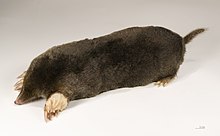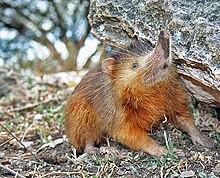Eulipotyphla
| Eulipotyphla Temporal range:
| |
|---|---|

| |
| Clockwise from upper left: a solenodon, hedgehog,[a] mole and shrew | |
| Scientific classification | |
| Domain: | Eukaryota |
| Kingdom: | Animalia |
| Phylum: | Chordata |
| Class: | Mammalia |
| Magnorder: | Boreoeutheria |
| Superorder: | Laurasiatheria |
| Order: | Eulipotyphla Waddell et al., 1999 |
| Families | |
| |
| Synonyms | |
| |
Eulipotyphla (/ˌjuːlɪpoʊˈtɪflə/, from eu- + Lipotyphla; sometimes called true insectivores[1]) is an order of mammals comprising the Erinaceidae (hedgehogs and gymnures); Solenodontidae (solenodons); Talpidae (moles, shrew-like moles and desmans); and Soricidae (true shrews) families.
Taxonomic history
[edit]Historically, these animals were grouped with others such as treeshrews, elephant shrews, and colugos, under the broader category Insectivora, comprising all small insect-eating placental mammals. Wilhelm Peters identified two sub-groups of Insectivora, distinguished by the presence or absence of a cecum in the large intestine.[2] In his 1866 Generelle morphologie der organismen, Ernest Haeckel named these groups Menotyphla and Lipotyphla,[2] respectively from μένω ("remain")/λείπω ("lack" or "leave behind") + τυφλὸν literally "blind", as in τυφλὸν ἔντερον ("blind intestine", from which the Latin intestinum caecum derives as a calque).[3][4]
Since the late 1990s, molecular studies have produced evidence that the Lipotyphla are not a monophyletic group. This led to tenrecs, otter shrews, and golden moles being placed a new order (Afrosoricida, in the superorder Afrotheria), with the remaining members of Lipotyphla being reclassified as Eulipotyphla.[2][5][6]
A 2023 study suggested that the order began to diversify prior to the K-Pg extinction, based on molecular clock estimates.[7]
Classification
[edit]



- Order Eulipotyphla (= 'Lipotyphla' - Afrosoricida = 'Erinaceomorpha' + 'Soricomorpha')
- Family Erinaceidae[10]
- Subfamily Erinaceinae: hedgehogs
- Subfamily Galericinae: gymnures or moonrats
- Family Soricidae[11]
- Subfamily Crocidurinae: white-toothed shrews
- Subfamily Soricinae: red-toothed shrews
- Subfamily Myosoricinae: African white-toothed shrews
- Family Talpidae[12]
- Subfamily Talpinae: Old World moles and desmans
- Subfamily Scalopinae: New World moles
- Subfamily Uropsilinae: shrew-like moles
- Family Solenodontidae: solenodons
- † Family Nesophontidae: extinct West Indian shrews
- † Family Amphilemuridae
- † Family Nyctitheriidae
- † Family Plesiosoricidae
- Family Erinaceidae[10]
Family-level cladogram of modern eulipotyphlan relationships, following Roca et al. and Brace et al.:[5][13]
| Eulipotyphla | |
The upper and lower basal subclades within the tree are the suborders Solenodonota and Erinaceota, respectively.[13] These two branches are estimated to have split ~72–74 million years (Ma) ago.[13][8][9] The Nesophontidae and Solenodontidae are thought to have separated roughly 57 Ma ago.[13] Split times for talpids vs. soricids plus erinaceids, and for soricids vs. erinaceids, have been estimated at 69 Ma and 64 Ma ago, respectively.[14]
Notes
[edit]- ^ Either a European hedgehog or a northern white-breasted hedgehog
References
[edit]- ^ Buckley, Michael; Harvey, Virginia L; Orihuela, Johanset; Mychajliw, Alexis M; Keating, Joseph N; Milan, Juan N Almonte; Lawless, Craig; Chamberlain, Andrew T; Egerton, Victoria M; Manning, Phillip L (2020-06-04). "Collagen Sequence Analysis Reveals Evolutionary History of Extinct West Indies Nesophontes (Island-Shrews)". Molecular Biology and Evolution. 37 (10): 2931–2943. doi:10.1093/molbev/msaa137. ISSN 0737-4038. PMC 7530613.
- ^ a b c Douady, C. J.; Chatelier, P. I.; Madsen, O.; de Jong, W. W.; Catzeflis, F.; Springer, M. S.; Stanhope, M. J. (October 2002). "Molecular phylogenetic evidence confirming the Eulipotyphla concept and in support of hedgehogs as the sister group to shrews". Molecular Phylogenetics and Evolution. 25 (1): 200–209. doi:10.1016/S1055-7903(02)00232-4. PMID 12383761.
- ^ Ohl, Michael (2018). The art of naming. Translated by Lauffer, Elisabeth. Cambridge, Massachusetts London: The MIT Press. pp. 7–9. ISBN 978-0-262-03776-1.
- ^ "caecum | Etymology of caecum by etymonline". www.etymonline.com. Retrieved 2024-10-23.
- ^ a b Roca, A. L.; Bar-Gal, G. K.; Eizirik, E.; Helgen, K. M.; Maria, R.; Springer, M. S.; O'Brien, S. J.; Murphy, W. J. (2004-06-10). "Mesozoic origin for West Indian insectivores". Nature. 429 (6992): 649–651. Bibcode:2004Natur.429..649R. doi:10.1038/nature02597. PMID 15190349. S2CID 915633.
- ^ Bininda-Emonds, O. R. P.; Cardillo, M.; Jones, K. E.; MacPhee, R. D. E.; Beck, R. M. D.; Grenyer, R.; Price, S. A.; Vos, R. A.; Gittleman, J. L.; Purvis, A. (2007-03-29). "The delayed rise of present-day mammals". Nature. 446 (7135): 507–512. Bibcode:2007Natur.446..507B. doi:10.1038/nature05634. PMID 17392779. S2CID 4314965.
- ^ Foley, Nicole M.; Mason, Victor C.; Harris, Andrew J.; Bredemeyer, Kevin R.; Damas, Joana; Lewin, Harris A.; Eizirik, Eduardo; Gatesy, John; Karlsson, Elinor K.; Lindblad-Toh, Kerstin; Zoonomia Consortium‡; Springer, Mark S.; Murphy, William J.; Andrews, Gregory; Armstrong, Joel C. (2023-04-28). "A genomic timescale for placental mammal evolution". Science. 380 (6643): eabl8189. doi:10.1126/science.abl8189. ISSN 0036-8075. PMC 10233747. PMID 37104581.
- ^ a b de Lazaro, Enrico (19 March 2018). "Solenodon Genome Sequenced". Sci-News.com. Retrieved 2019-06-23.
- ^ a b Grigorev, K.; Kliver, S.; Dobrynin, P.; Komissarov, A.; Wolfsberger, W.; Krasheninnikova, K.; Afanador-Hernández, Y. M.; Brandt, A. L.; Paulino, L. A.; Carreras, R.; Rodríguez, L. E.; Núñez, A.; Brandt, J. R.; Silva, F.; Hernández-Martich, J. D.; Majeske, A. J.; Antunes, A.; Roca, A. L.; O'Brien, S. J.; Martínez-Cruzado, J. C.; Oleksyk, T. K. (2018). "Innovative assembly strategy contributes to understanding the evolution and conservation genetics of the endangered Solenodon paradoxus from the island of Hispaniola". GigaScience. 7 (6): giy025. doi:10.1093/gigascience/giy025. PMC 6009670. PMID 29718205.
- ^ Kim, N.H.; Lim, S.J.; Chae, H.M.; Park, Y.C. (2017). "Complete mitochondrial genome of the Amur hedgehog Erinaceus amurensis (Erinaceidae) and higher phylogeny of the family Erinaceidae". Genetics and Molecular Research. 16 (1). doi:10.4238/gmr16019300. PMID 28198504.
- ^ Dubey, S.; Salamin, N.; Ohdachi, S.D.; Barrière, P.; Vogel, P. (2007). "Molecular phylogenetics of shrews (Mammalia: Soricidae) reveal timing of transcontinental colonizations". Molecular Phylogenetics and Evolution. 44 (1): 126–137. doi:10.1016/j.ympev.2006.12.002. PMID 17267241. S2CID 3136125.
- ^ He, K.; Shinohara, A.; Helgen, K.M.; Springer, M.S.; Jiang, X.-L.; Campbell, K.L. (2017). "Talpid Mole Phylogeny Unites Shrew Moles and Illuminates Overlooked Cryptic Species Diversity". Molecular Biology and Evolution. 34 (1): 78–87. doi:10.1093/molbev/msw221. PMID 27795230.
- ^ a b c d Brace, S.; Thomas, J. A.; Dalén, L.; Burger, J.; MacPhee, R. D. E.; Barnes, I.; Turvey, S. T. (2016). "Evolutionary History of the Nesophontidae, the Last Unplaced Recent Mammal Family". Molecular Biology and Evolution. 33 (12): 3095–3103. doi:10.1093/molbev/msw186. PMID 27624716.
- ^ Springer, M. S.; Murphy, W. J.; Roca, A. L. (2018). "Appropriate fossil calibrations and tree constraints uphold the Mesozoic divergence of solenodons from other extant mammals". Molecular Phylogenetics and Evolution. 121: 158–165. doi:10.1016/j.ympev.2018.01.007. PMID 29331683.
